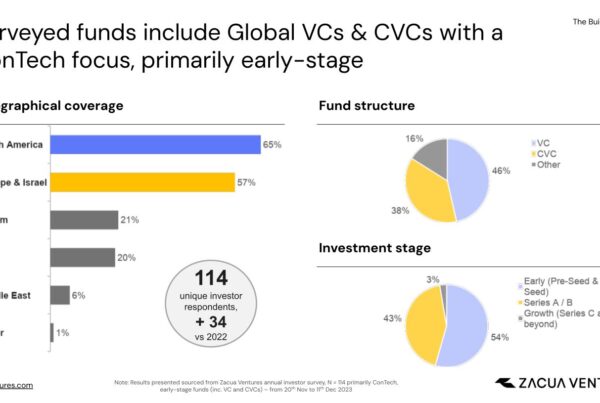EXECUTIVE SUMMARY
Whether you think software is eating the world or that robot overlords are coming for your job (they aren’t, we promise), there are more construction technology solutions now than ever before. Venture funding in construction has steadily grown over the past 10 years, from $300 million yearly in 2013 to $7 billion as of 2022. However, the adoption of technology at the construction site hasn’t followed such a straight and uniform path. Increasingly, the gap in tech adoption among construction companies is widening and this will likely create winners and losers in this space. Whether your company is an advanced player in tech adoption or a laggard, this report will highlight the key measurements for a successful implementation of a tech adoption strategy including best practices around piloting and scaling new technologies. We set the stage with a brief overview of the timeline of technology adoption on jobsites and highlight key drivers of adoption. Then, we discuss the different stages of tech adoption in construction companies and share a framework to assess your organization’s readiness.
These sections show practical insights into the benefits reaped by early adopters, as well as the challenges faced by those who have been slower to embrace new technologies. These learnings will enable construction managers to make informed decisions and develop a roadmap for their company’s technology adoption journey and startup founders to better position their startup and align their offerings with market needs, anticipate potential roadblocks and develop strategies to address them.
We will wrap up by providing valuable insights into the upcoming trends in construction technology, with specific emphasis on the potential of AI in the construction technology landscape.
DIGITIZATION TIMELINE: UNDERSTANDING THE STAGES OF TECHNOLOGY ADOPTION
In our experience researching and investing in construction technology since 2016, we have observed that the path to adopting technology is not always straightforward. However, supported by in-depth interviews with a group of remarkably forward-thinking construction companies around the globe, we have examined the practices and the evolution of their technology adoption paths, in which we have identified common patterns that we have categorized in four main stages of tech adoption:
Digitization 1.0: Digital Tools replacing pen & paper
The early years of construction technology adoption presented simple digitization of existing workflows to replace pen and paper processes. The goal of these solutions was to digitize existing workflows without changing the process of work and included solutions like manual data entry from paper into a computer, marking what we refer to as Digitization 1.0: At this stage, the primary objective was to improve a one-way flow of information, primarily from the office to the jobsite, laying the foundation for the subsequent stages of digitization within the construction management landscape.
The advent and widespread adoption of smartphones revolutionized the way construction managers worked and communicated. Mobile devices such as cell phones and tablets started to make their way onto job sites, reshaping workflows. With them, communication and information sharing became faster and more efficient: phone calls, text messages, emails, and the sharing of digital documents, such as spreadsheets, became commonplace. Moreover, the incorporation of mobile applications played a pivotal role in the early stages of digitization. This initial era of digitization gave rise to a surge in “point solutions“: digital workflows designed to address specific isolated tasks or stages in the construction process, without integrating with other workflows or processes.
Also, one of the earliest digital technologies to be implemented in many construction companies was BIM. As such, in the different interviews we’ve done, we noticed that Innovation departments have frequently started within their VDC teams.
We can then summarize the initial steps to digitization in the following types of technologies:
- Communication & coordination tools: enabling better information workflows between the office and the field.
- Field productivity: replacement of pen & paper in existing workflows on the jobsite.
- Project Management & cloud computing: initial steps towards moving to a cloud environment to manage projects.
- BIM: As mentioned, one of the earliest digital technologies, moving from 2D to 3D designs, primarily driven by owner requests and regulation.
🏆 Best practices at this stage of tech adoption:
During this initial step of digitization there isn’t a culture around innovation and people tend to be reluctant to test new apps or transition their legacy software to an on-cloud project management one. Innovation responsibilities tend to be added to business areas that have other responsibilities, to people that are tech-curious or to a newly created department with low or no exposure to jobsites or other business units. Hence, the key characteristics we have identified in companies that have successfully gone through this stage are:
- The simpler, the better: Look for repetitive processes that are currently being done very inefficiently and focus on these as the first step to digitize (RFIs, Submittals, etc.).
- Focus on quick wins: choose startups that, based on their tech stack and user interface, are very easy to implement, deploy and obtain results.
- Get involved in pilots’ deployment: Besides finding a team that’s open to testing new things and taking ownership of the pilot, the innovation lead needs to be quite hands-on, identify potential roadblocks, simplify the field team’s work to the extent possible, and provide support on assessing the productivity gains during the pilot.
- Start with office staff first, then push things to the field crew: Office people tend to be more open to testing new technologies, while field crew need to be convinced there are no risks involved.
- Start building an ecosystem of partners: Being reactive only takes you so far. In order to start implementing the best technologies, it is crucial to have access to them, being able to compare and determine the best suited startups for the company’s needs. As startups, by definition, are early stage and not easily known, it is crucial to develop an ecosystem of partners (investors, tech associations, other innovation teams) to share knowledge on the ecosystem and to access the most promising startups.
Digitization 2.0: Workflow efficiency and the advent of virtual work
Digitization 2.0 marked a significant advancement as tools emerged to streamline workflows by simplifying or consolidating steps, establishing new processes, and expediting existing ones. The core aim was to enhance operational efficiency on construction sites: notable examples include the digitization of RFIs, submittals, and schedules, alongside reality capture tools and the migration of operations to cloud-based storage platforms.
With Digitization 2.0, we transition from a one-way information flow to a seamless two-way exchange of information between the jobsite and the office, greatly accelerating the pace of communication and facilitating quicker, well-informed decisions. The onset of the pandemic played a pivotal role in driving the adoption of these technologies: the surge in remote work coupled with the escalating data volumes made the case for the transition from on-premises legacy systems to cloud-based counterparts, enabling teams to collaborate online in nearly real-time.
The digitization of new workflows also had the effect of creating information silos that were not connected to each other or to existing on-prem solutions. As a result of this, we started seeing the demand for more data integration solutions, sometimes with an integration required for each new technology solution, resulting in numerous integrations per project, which is complex and costly to maintain.
In this second step of digitization, we have seen the adoption of following types of technologies:
- Mobile Apps and Field Productivity: Optimizing workflows on the jobsite, empowering field personnel with tools for field reporting, task management, punch list tracking, and quality control.
- Reality Capture software: From drones to 360º photo capturing, laser scanning and fixed cameras, these apps allow for an accurate and efficient capture of real-world data and environments, providing valuable insights easily shared among project stakeholders, providing a clear and comprehensive view of the site.
- IoT devices: The integration of IoT devices and sensors on construction sites increased during this period. IoT-enabled solutions provided real-time monitoring of equipment, environmental conditions, and safety parameters, leading to improved asset management and enhanced job site safety.
- Cloud Computing and Collaboration: Big push towards replacing on-premise / legacy software. Cloud-based platforms offered secure storage, real-time access, and facilitated seamless collaboration on project documents, drawings, and models across distributed teams.
🏆 Best practices at this stage of tech adoption:
At this stage, technology adoption is likely garnering excitement within the organization through quick wins and workflow updates. It is important for construction companies to begin the involvement of the different teams, avoid duplication of efforts and misalignment across projects, optimize resources and start thinking about enterprise expansions. As organizations begin to formalize a technology strategy, there will be a shift from a curiosity-driven approach to a more organized approach to piloting and implementing technology. Hence, our top recommendations at this stage are:
- Enable Jobsite engagement: With the quick wins introduced early in the digitization process, there’s a risk that innovation teams want to push more complex technologies, which could lead to big failures. At this stage, it is crucial to involve jobsite teams in understanding their main pain points, prioritizing and in the selection of the techs to be tested and deployed on their projects. One contractor defined this as a subtle move from “push” to “pull”, focusing on communication campaigns to present different techs, get people excited and wait to be demanded by their teams.
- Develop an Innovation strategy: Technology solutions may be mainly focused on project-level solutions rather than for the broader organization. A project-level focus is positive in that it allows techs to solve clear pain points on jobsites, but this limits scalability within the organization for an enterprise technology adoption. Innovation teams should make sure projects aren’t working in silos, there’s a consistent sharing of information and try to unify their roadmap of tech implementation.
- Ensure special emphasis on culture: Not all parts of the organization will be excited about technology adoption, this is normal and expected. There may still be some resistance to technology that changes workflows or seems ¨too different”. At this stage, it is important for organizations to be comfortable with the risks, opportunities, and costs of working with technology, particularly building the understanding that some will fail.
- Calculate your ROI: As important as it is to find solutions that solve tangible pain points, innovation teams should also focus on proving the direct impact the technologies have on project savings, quality improvements, productivity gains, etc. This will be critical as they move from project-based solutions to enterprise deployments.
Digitization 3.0: Rise of centralized data platforms
The increased deployment of technology in construction companies, coupled with the digitization of the processes and workflows and the move to On-Cloud software results in the creation of substantial digital project data. However, this data often remains siloed, hindering its potential to provide a holistic view of the project and its different areas. For instance, the connection between schedules and financial information, the relation between worker tasks and safety incident reports, and other key insights are often missing. Moreover, challenges persist in effective communication and information handling throughout the project lifecycle (design-build-operate) and among the various stakeholders involved (subs, GCs, owners), frequently using different software.
Digitization 3.0 starts with the birth of centralized data platforms: addressing all the aforementioned conditions, the industry recognizes the limitations of point solutions in terms of data silos, communication gaps and inefficiencies, hence, digital platforms emerge as integrated solutions that bring together diverse data sets, tools and functionalities under a single and unified ecosystem.
We define digital platforms as software solutions that centralize data from different sources and allows information flow in different directions: A) Horizontally: Data flow across the different stages of the projects (design-construction-operation), B) Vertically: Connecting the different stakeholders involved in a project in each stage, and/or C) Diagonally: integrating data from different software being used by the same stakeholder.
In this third step of digitization, we can summarize the adoption of following types of technologies:
- Pre-construction platforms: Pre-construction is one of the areas in which there’s a big gap in technology developments (outside of design tools like BIM). However, there are emerging approaches to platform plays in this area offering end-to-end support for tasks like design collaboration around BIM, materials take-off, estimating, bidding, and more. These platforms ensure data consistency, seamless data transfer, and collaboration across different stakeholders involved.
- Business Analytics: Business analytics improves the analysis, interpretation, and visualization of data to identify trends, patterns, and opportunities to monitor project performance in real-time. Data from various sources, such as project schedules, budgets, and resource allocations, are analyzed to create informative dashboards and reports. This helps project managers and stakeholders track progress, identify potential bottlenecks, and make timely adjustments.
- Supply Chain integration: Frequently overlooked in the initial phases of tech adoption, supply chain constitutes one of the biggest areas for productivity improvement and efficiency gains: platforms play a key role in different processes, from accessing new suppliers, easily comparing quotes, e-purchasing, more efficient material deliveries, inventory management, demand forecasting, better financing alternatives, etc. Allowing information flow across the supply chain of a project has tremendous opportunities, but also deals with big challenges around transparency and cultural barriers.
🏆 Best practices at this stage of tech adoption:
Companies that reach this stage of tech adoption are at the forefront of process digitization, data capturing and data transfer. They are not only focused on technology to improve current workflows but are also evaluating technologies to disrupt or replace existing ones. At this stage, the organization is efficient enough to run multiple or continuous pilots without being burned by it.
To further accelerate adoption, the industry (startups, builders, developers, and suppliers) needs to identify data sets that are valuable for solving the industry’s hardest challenges and begin to integrate datasets to each other to avoid massive data silos that are unable to work together. Hence, some of our recommendations are:
- Adopt a strategic approach to piloting: As the company reaches maturity and there’s a formal roadmap for tech adoption, it needs to prioritize (together with PMs) the main areas for innovation while leaving a room to opportunistically test new technologies. Consequently, projects should have a mandate to contribute to the overall company innovation strategy and have clear guidance on which technologies they can test, with different compliance criteria (e.g., integration and security compliance requirements) while not smothering the spirit of innovation.
- Glean new insights from data: Innovation teams need to bring new perspectives to the extensive project data being captured and keep looking for ways to turn different data sets into actionable insights.
- Consolidate the tech stack: Technology by itself won’t solve all problems nor deliver the project on time and on budget. It is important to make it easier for the jobsite crew to interact with it, streamline and consolidate the tech stack and try to interconnect everything in a central platform. This will improve the crew member experience, increase data integrity and information quality control.
- Share lessons learned: As the industry is still nascent from the view of tech adoption, it is important that innovation leaders share their experiences of tech adoption and help the industry progress. This could be through social media, talks, or industry events. This also helps build your brand as an innovative leader. Sharing this information with startups can also help them better understand how best to engage with potential customers.
Although we have defined clear stages for technology adoption, there is not a linear path to technology adoption. Some organizations may start with a disruptive, innovative technology that changes workflows, while others may choose to start with small process improvements or simple digitizations of existing workflows. The choice depends on the culture of innovation within the organization, the type of project work performed, and the broader technology innovation goals.
Based on our research, these three stages represent the digitization journey the construction industry has gone through so far. However, there are a few examples of forward-thinking companies that have gone beyond these stages, and that are starting to explore new frontiers of tech implementation together with disruptive startups and are re-thinking the way the industry should work. In the next section, we will uncover some of these promising technologies that will likely constitute the future of technology adoption in the industry.
Digitization 4.0: The Future of Technology Adoption in Construction
As the industry becomes more comfortable with technology, there’s a growing emphasis on exploring alternative workflows, challenging traditional industry dynamics, envisioning the evolution of the roles of different stakeholders, and bringing deep tech to solve some of the most pressing problems like skilled labor shortages, affordable housing, and carbon footprint reduction.
Based on our interviews as well as our experience in the ecosystem, we have built a list of the most promising technology areas we see coming to the industry with the highest potential to make an impact.
- Automated Data Capture: Data capture and progress tracking solutions have proliferated rapidly in the industry, creating a whole new avenue to access real time data on project performance. Nevertheless, these technologies still rely on human input and hence, are susceptible to (deliberate or unintentional) errors or incongruencies. Next generation technologies are using a combination of computer vision, sensors fusion and AI (in some cases no-code AI) to interpret the jobsite conditions and provide insights on project progress, quality control, safety hazards, etc. From these insights, we could unlock an endless list of opportunities like predictive scheduling, automated material delivery, dynamic assignment of tasks to crew teams, etc.
- Artificial Intelligence: As in any other industry, AI holds immense potential to revolutionize and enhance the development of construction projects, particularly thanks to the ¨data revolution¨ we’ve seen in the latest years with the implementation of digitization technologies. With the use of AI, we can move from descriptive data which tells us what is happening, to prescriptive data, which provides recommendations of actions, to predictive analytics, which uses data to tell us the likely outcomes of events. AI can also automate repetitive process and lower the burn of construction professionals, analyze historical data to predict future project outcomes, identify potential risks, quantify these, and propose alternative paths or mitigations strategies, and so on. Generative AI, in the future, could also enable automation of extremely time-consuming tasks like architectural and structural design. The range of applications is so vast that we can’t be but excited about the new developments in this area.
- Robotics and Human Augmentation: There are two main drivers accelerating the implementation of these technologies. Firstly, the rapid increase of skilled labor shortages and declining cost of robotics making them a more cost-effective solution, and secondly, the changing role of stakeholders: As technology further integrates into project management functions, project owners have more visibility and want to reduce waste while General Contractors on the other hand are looking at ways to expand their responsibilities and ownership in a project. Consequently, companies are becoming more open to testing technologies that enhance or support unskilled labor with new robotics applications, exoskeletons and industrialized construction solutions. These have also a focus on health and safety, focusing on automating dangerous or repetitive tasks. We have explored these in our Construction Robotics Report.
- Sustainability: This is becoming a significant focus in the construction industry, driven by environmental concerns, regulatory requirements, and the demand for more resource-efficient and environmentally friendly practices. As the application of sustainable technologies evolve and the unit economics makes it more attractive for a wider application, areas like alternative materials, circular economy, net zero energy buildings, water conservation and alternative energy sources will become mainstream in the execution of projects. We have explored one of these areas in our report on The Path to Green Concrete
- Preconstruction: According to some of our interviewees, preconstruction remains highly untouched in terms of new technology implementation. Although the design piece is already controlled by a few software, the potential for optimization of this design and the connection with the subsequent phases (estimation, bidding, planning & scheduling) presents a lot of opportunities new startups are active exploring to improve. This may not be solved by one specific technology rather with the combination of software, AI, platforms, etc.
CONCLUSIONS
Today, hardware and software are being combined in new ways to drive technology adoption. The pace of change is faster now than ever before, and we’ve moved from Digitization 1.0 to Digitization 4.0 in a few years time, even if traditionally the industry has been amongst the slowest to digitize. Some key factors leading this digital revolution were the invention and penetration of smartphones and tablets, a driving need to continue working together when unable to be in-person, the proliferation of new digital tools like IoT and AI, and the creation of complex data sets that needs to be stored, organized, and analyzed.
The construction industry is often described as not innovative, but this brief review of digitization demonstrates the industry’s ability to problem solve and leverage technology solutions for the industries biggest problems. It is important now to continue developing technology solutions that drive better communication between stakeholders in the value chain.
Although startups and forward thinking companies are embracing Digitization 4.0, the fragmented nature of the industry means that not every organization is at the same level of digitization. This creates challenges to collaborative work and for entrepreneurs developing new solutions trying to capture market share. The fragmentation also risks wasted time and money for everyone if technology solutions are not effectively leveraged across different stakeholders.
Software wins over hardware in cost and scalability, but construction remains a physical activity requiring physical assets and labor. The implementation of hardware technologies has the potential to unlock major benefits in quality, consistency, productivity, and sustainability. Yet, there are still many barriers to broader adoption of these technologies including higher cost, pricing models, training requirements, and broader accessibility.
As industry stakeholders grasp the utility of data being collected, data integrity and control and monitoring of data collection are of growing importance. With more data available, there will be more value to be added in the entire project lifecycle, from design, to construction, to final building management and maintenance.
There is also likely to be consolidation of technology solutions. Industry leaders in piloting and adopting new technologies now desire to rightsize the number of technology solutions and find connectivity across solutions. Many existing solutions are expanding the quantity of features offered in the movement from point solution to platform, but partnerships and acquisitions are likely to play roles in consolidation.
Finally, we shouldn’t overlook the role technology could have in modifying the most fundamental industry dynamics and the role the different stakeholders play in it. Will GCs maintain their management role? Will subcontractors modify their teams’ structures and skills sets? Will suppliers further integrate down the value chain? These are some of the fundamental questions we’re constantly asking ourselves and our partners.
As an early-stage construction technology investment fund, Zacua Ventures is passionate about successful, scalable, and sustainable technology. We’d love to hear from you about your technology needs or interests if you are a technology adopter at any stage in your adoption process.









